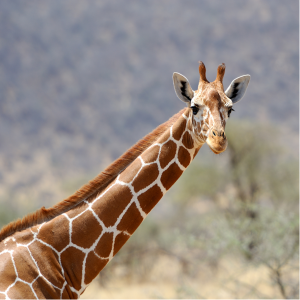
Journeying into the giraffe genome
 A trip to the zoo is not complete without seeing iconic wild animals—from lions to tigers to bears, oh my. But towering above them all are the gentle giants of the grasslands and woodlands of Eastern Africa, giraffes. Giraffes are the world’s tallest land animals, thanks in part to their unusually long necks. Adult male giraffes measure in at a whopping 18 feet, with necks the length of an adult human.
A trip to the zoo is not complete without seeing iconic wild animals—from lions to tigers to bears, oh my. But towering above them all are the gentle giants of the grasslands and woodlands of Eastern Africa, giraffes. Giraffes are the world’s tallest land animals, thanks in part to their unusually long necks. Adult male giraffes measure in at a whopping 18 feet, with necks the length of an adult human.
While it is unclear exactly why giraffes have such long necks, many scientists have theorized over the years. One of the most popular, but inaccurate, theories originated in the early 1800’s from French naturalist Jean Baptiste Lamarck. He suggested that the giraffes’ long neck evolved because they were continually stretching their necks to reach food atop tall trees.
Regardless of the origin of their long necks, scientists agree that giraffes’ tall stature affords them many selective advantages like giving them access to otherwise inaccessible food and providing an excellent vantage point to detect approaching predators.
However, their unique anatomy also presents them with considerable biological challenges. For example, they must maintain a blood pressure that is roughly 2.5 times higher than that of humans in order to pump blood from their heart all the way up their long neck to their brain. A group of scientists recently published a new study that helps explain how giraffes adapted to accommodate their unusual body architecture.
Understanding giraffeness
Taking advantage of new genomic sequencing technologies, the research team generated an updated and more complete giraffe genome. The first giraffe genome was published in 2016 but with few related genomes to compare it to at the time, it was far from complete and only mapped about two-thirds of the giraffe’s DNA. The new giraffe genome has almost 98 percent coverage.
By comparing the giraffe genome to those from other mammals, the scientists found 500 genes that are either unique to giraffes or contain DNA changes found only in giraffes. Interestingly, many of the genes were associated with growth and development, nervous and visual systems, circadian rhythms, and blood pressure regulation, all areas in which the giraffe differs from its close relatives. 
These giraffe genes are associated with adaptations that allow giraffes to survive and thrive even with their unusually long body structure. Some of the genes give giraffes more accurate eyesight, which is critical when scanning the horizon for possible predators. Others give giraffes an altered circadian rhythm that leads to shorter and more fragmented sleep patterns. This is important because their tall, lanky bodies make it difficult for them to stand quickly, so they sleep lightly, often sleeping in a standing position, to avoid being attacked by predators.
One gene called FGFRL1 stood out among the group of unique genes. In humans, FGFRL1 is involved in cardiovascular development and bone growth. The scientists hypothesized that this gene could be involved in giraffe’s adaptations to their tall stature.
To test their hypothesis, the scientists turned to CRISPR technology to insert the giraffe-type FGFRL1 gene into mice. The mice carrying giraffe FGFRL1 didn’t have longer necks, but scientists did notice some interesting bone-based features.
Mice carrying the giraffe version of the gene had faster bone growth and higher bone density compared to typical mice. Since giraffes have the fastest growing bones of any known animal, scientists concluded FGFRL1 is likely involved in the rapid process of giraffe bone development and also maintains high bone density for strong neck bones.
To determine if FGFRL1 is also involved in blood pressure regulation, the scientists gave mice with and without the giraffe version of FGFRL1 a drug called angiotensin II to increase their blood pressure. After 28 days, the typical mice had developed high blood pressure but the mice with the giraffe version of FGFRL1 had normal blood pressures, suggesting that giraffe FGFRL1 protects against high blood pressure. This insight could help efforts to develop treatments for high blood pressure in humans.
To schedule a media interview with Dr. Neil Lamb or to invite him to speak at an event or conference, please contact Margetta Thomas by email at mthomas@hudsonalpha.org or by phone: Office (256) 327-0425 | Cell (256) 937-8210

